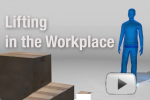What are you doing to prevent musculoskeletal injury (MSI) among workers who lift, move, and load materials?

From WorkSafeBC video
BC organizations are invited to share their story on how a manual materials handling task was improved through a physical change in the workplace or through a change in the work process.
WorkSafeBC’s Innovations Contest runs during the month of October during Occupational Ergonomics Month. The winning organization receives a group lunch (up to $200) for sharing what they did to ease the load on workers who do manual materials handling tasks.
This includes “… any task where loads are moved from a location to another without the assistance of a mechanical device, examples include lifting, pushing, pulling or carrying,” says the challenge invite.
In 2012, the winner was Canada’s Michael Smith Genome Human Sciences Centre. Their new cart and cable system takes the load off workers who were lifting liquid nitrogen canisters used for transporting biological samples.
To find out more, I emailed WorkSafeBC ergonomist Gina Vahlas. I asked what employers get out of participating.
“They get to improve a task that involves manually moving loads – leading to a reduction of musculoskeletal injury risk in their organization and possibly improved efficiency and reduced injuries/costs,” Gina said. “These injuries are the leading cause of injury in many workplaces.”
Tips on taking the challenge
Gina said the best solutions often come from people who do the job.
“Sometimes people tell me that they came up with an easier way to do the job so they could be more efficient. Because they weren’t calling it ergonomics in their mind, they think these solutions do not count. But they do count! These ideas are the kinds of solutions we are looking for.”
She also shared this advice for first-time participants.
“Before and after pictures are very helpful in showing the task and the improvements,” she said. “If you haven’t implemented a solution yet, now is your chance to start.”
“Consult with your workers to come up with possible solutions. Test out the possibilities to make sure that they do not introduce other problems. Implement the solution. If the solution hasn’t been fully implemented by the end of October, you can submit your plans in the contest this year and then submit the implemented solution next year.”
Thanks to Gina – and good luck to all.


